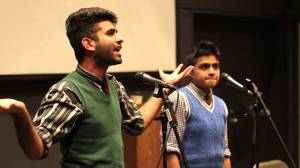Since the Milo Yiannopoulos protest at UC Berkeley weeks ago, I’ve been struggling to explain to people in my life what exactly happened.
I tried to move on, but continued to be troubled by the coverage in most mainstream media outlets because they focused on property damage and literal fireworks instead of the racism we were fighting.
Since that day, there have been countless airport protests, pro-Trump and anti-Trump rallies, raucous town hall meetings.
People keep asking me the same questions about violence and social protest.
“What is the point of these disruptive, violent actions? Why can’t you all peacefully protest?”
Toward that end, I want to offer a couple of ways that this super active political climate requires all of us to rethink violence right now.
So maybe the Women’s March was your first march, and you were pleased with how peaceful the whole thing was.
“This is how protests should be,” you thought, even if it wasn’t as inclusive as it could’ve been.
Maybe you think the Black American Civil Rights Movement was peaceful. And now you’re wondering, what’s up with those Black Lives Matter people and their disruptive protests? Don’t they know this isn’t what Martin Luther King, Jr. would’ve wanted?
Maybe you’re struggling with whether or not to punch Nazis, because “Doesn’t that mean we’re just stooping to their level?”
If any of that sounds like you, read on. Because violence can mean something altogether different – and often unexpected – in the context of activism and social justice.
And if you’re missing that, then you might not be grasping the full picture of the real change that needs to happen.
1. Non-Violent Action Has Always Been Violent
There’s a great book by activist Charles E. Cobb, Jr. about the relationship between militant self-defense and nonviolence during the Black American Civil Rights Movement.
In the text, Cobb makes a pretty straightforward argument about how the two are related. He says, “nonviolence worked so well as a tactic for effecting change and was demonstrably improving their lives, some Black people chose to use weapons to defend the nonviolent Freedom Movement.”
So the Black Panthers, but also many other groups including AIM, I Wor Kuen, and the Young Lords all advocated militant self-defense as a way of protecting themselves and the nascent rights they achieved during this time.
In other words, the Civil Rights Movement that you think of as nonviolent actually included many actions that you might consider violent.
Moreover, it’s important to note that the super nonviolent act of existing as a person of color has historically been in and of itself enough to get you killed.
Indigenous, Latinx, Asian, and Black people have been continuously killed for minor – if any – offenses.
One of the most well known of these cases is the lynching of young Emmett Till for supposedly whistling at a white woman. In a book that just came out, the woman whose testimony, more or less, exonerated Till’s murderers admits to lying about the incident that caused his death.
Sandra Bland died in jail after being pulled over for a traffic ticket. Trayvon Martin was killed for walking in a gated community. Young Tamir Rice for holding a toy gun. Most recently, Srinivas Kuchibhotla for sitting in a bar with friends.
Finally, there’s a Buzzfeed list of photos I regularly show to my students because they do such a good job of illustrating the violence SNCC members willingly put themselves through as a part of preparing for “non-violent” sit-ins.
In the pictures, you see young Black students being beaten, having their hair pulled, and having smoke blown in their faces as a part of preparation for what is it to come.
And that was just the training.
Violence has always been committed upon the bodies of activists – whether it’s being mauled by dogs in Montgomery in the 1960s or being shot by rubber bullets at Standing Rock last year.
During the anti-Milo protest at UC Berkeley, the Buzzfeed coverage included a commentator saying, “there’s violence against windows” in a really panicked way. But we need to start acknowledging that physical harm at the hands of police and the government as a form of violence is very different from property damage in Ferguson.
It’s time to recognize that not all violence is created equal. Part of nonviolent protest has always been violent, and in fact, some of what we call “violence” might not be violence at all.
2. What’s Legal Isn’t Always What’s Right
A lot of people are encouraging activists to stay within the limits of the law when it comes to direct actions resisting their oppression.
If you agree with these people, you might claim that the US has mechanisms in place for state-sanctioned protests. You tell us, “don’t break windows, don’t disrupt the peace, don’t assemble without a permit,” and so on.
In other words, don’t stray from the boundaries of what the government has decided is legally permissible.
But allow me to remind people that the law has never been race neutral and often, it hasn’t been fair.
Here are some things that have been legal: Jim Crow segregation. Lynching. Slavery. Colonialism. Rape of women of color.
On the flip side, here’s what has been illegal: Interracial marriage. Queer sex. Drinking. Chinese men wearing ques (traditional braids). Speaking non-English languages at school.
Often, what’s legal is a pretty inaccurate way to measure what’s right.
Dr. Martin Luther King, Jr. was arrested thirty times in ten years, between 1955 and 1965, because sharing space with white people and voting was illegal if you were a person of color.
So asking oppressed people to respect law and order often means asking us to abide by systems that historically, and currently, rob us of human dignity.
By doing this, you’re ignoring the fact that someone can simultaneously abide by our laws, yet still do something violently oppressive – which happens all the time.
On the other hand, you’re moreover neglecting the fact that an activist could break the law, and in the process, do something revolutionary for the sake of liberation. Which also happens all the time.
Simply put, the law isn’t that great a way to measure whether a political action is just.
Submitting to oppressive laws has not worked historically, and we may be experiencing another moment of its naked failure.
3. Civil Disobedience Needs to Be Disruptive
Oppression was and often remains legal.
The current administration just rolled back protections on transgender people’s ability to use the bathroom that corresponds to their gender identity. Mississippi has exactly one abortion clinic. Federal prisons incarcerate trans women at exceptionally high rates. The rate of women in prison has ballooned fourteen-fold in the last few decades.
This is the status quo, which means the goal of civil disobedience must be disruption of what’s “normal.”
Every day since the inauguration, Hari Kondabalo has been tweeting “Reminder for day [number of days Trump has been in office] of Trump Presidency: this is not normal.” And god bless him for doing it because, as time has told us, it takes a lot for people to push back against what we’re used to.
On a more personal note, I’ve experienced this a number of times as a survivor of domestic abuse. When I was younger, people would always tell me that my father “didn’t mean it” when he hit me or screamed at me.
It wasn’t until my mid-twenties that I could see how my ideal of “normal” was actually really violent and oppressive. I believed victim-blaming and patriarchal explanations until I could see clearly and force him out of my life.
Civil disobedience requires that we resist what looks, feels and frequently functions like the same old system we’ve grown accustomed to our entire lives.
It means we decide en mass to walk out of work or school, to strike and boycott our favorite restaurants or rideshare apps because we must interrupt the ways economic, political, and physical violence has became routine.
4. Ask Who Is the Least Safe – And Why
A huge part of the Milo protest was prevention. He was going to out undocumented students just like he had outed transgender people in the past.
During Yiannopoulos’s talk at the University of Milwaukee, a trans student’s picture was broadcast to the crowd and mocked. Afterward, in an open letter to the administration, the student wrote: “I am done getting repeatedly abused and shit on, and expected to just take it and not be angry.”
When we spend all of our time protecting the rights to “free speech” (harassment isn’t free speech, by the way) we’re protecting the rights of racists, transphobes, and pedophile apologists at the cost of the marginalized people who actually matter in this equation.
We need to ask, who is the most unsafe here? Is it the millionaire white person with a fetish for dating Black men, or is it the trans, undocumented student whose life will be made a living hell when they’re outed to a room of 900 white supremacists?
We need a new equation for knowing who to protect and why. If we’re really going to love and support each other, we need to start by asking, “who’s the least safe and why?”
I know a lot of folks who went to North Dakota to be in solidarity with the Standing Rock water protectors. They weren’t Native themselves, but they could recognize that while this one corporate pipeline will effect all of us eventually, it disproportionately affects the Indigenous people of this region right now. So being in alignment with social justice means coming to their aid.
What I’m calling for isn’t a form of the oppression olympics in which we rate everyone’s level of marginalization.
I’m asking that we consider how some people at any given moment will bear the brunt of a racism, transphobia, and heteropatriarchy unevenly and that those of us with the relative ability to do so must show up to be in solidarity with them as needed.
***
Violence is hard to unpack because it’s so incredibly subjective.
I gave that Buzzfeed reporter who talked about the violence perpetrated upon windows a lot of shit at the beginning of this article, but I’m not foreclosing the possibility that he was really scared.
Because I get scared, too.
I can’t handle masculine-presenting folks yelling at me because of my past trauma. I have a hard time walking downtown at night because I’ve been assaulted with a weapon in a major city. No one is saying you need to be okay with what you perceive as a violent action if it’s happening right in front of you. You don’t need to stick it out.
But we all need to be more critical about how we define violence, because we’re seeing a lot more marching, protesting, and direct action than has previously been covered in mainstream news media.
And while it might make us uncomfortable to acknowledge, violence is often a necessary tool of resistance. The sooner we recognize that, the sooner we can end oppression.
[do_widget id=’text-101′]
Kim Tran is a Contributing Writer for Everyday Feminism. She’s also a collective member of Third Woman Press: Queer and Feminist of Color publishing. Her academic and activist commitments are to laborers, refugee and queer communities. She is finishing her Ph.D in Ethnic Studies at UC Berkeley where writes on race, gender, and economics. Her work has been featured on Black Girl Dangerous, Nation of Change and the Feminist Wire. She can be found in any of these capacities at her website. Read her articles here.
Search our 3000+ articles!
Read our articles about:
Our online racial justice training
Used by hundreds of universities, non-profits, and businesses.
Click to learn more





















